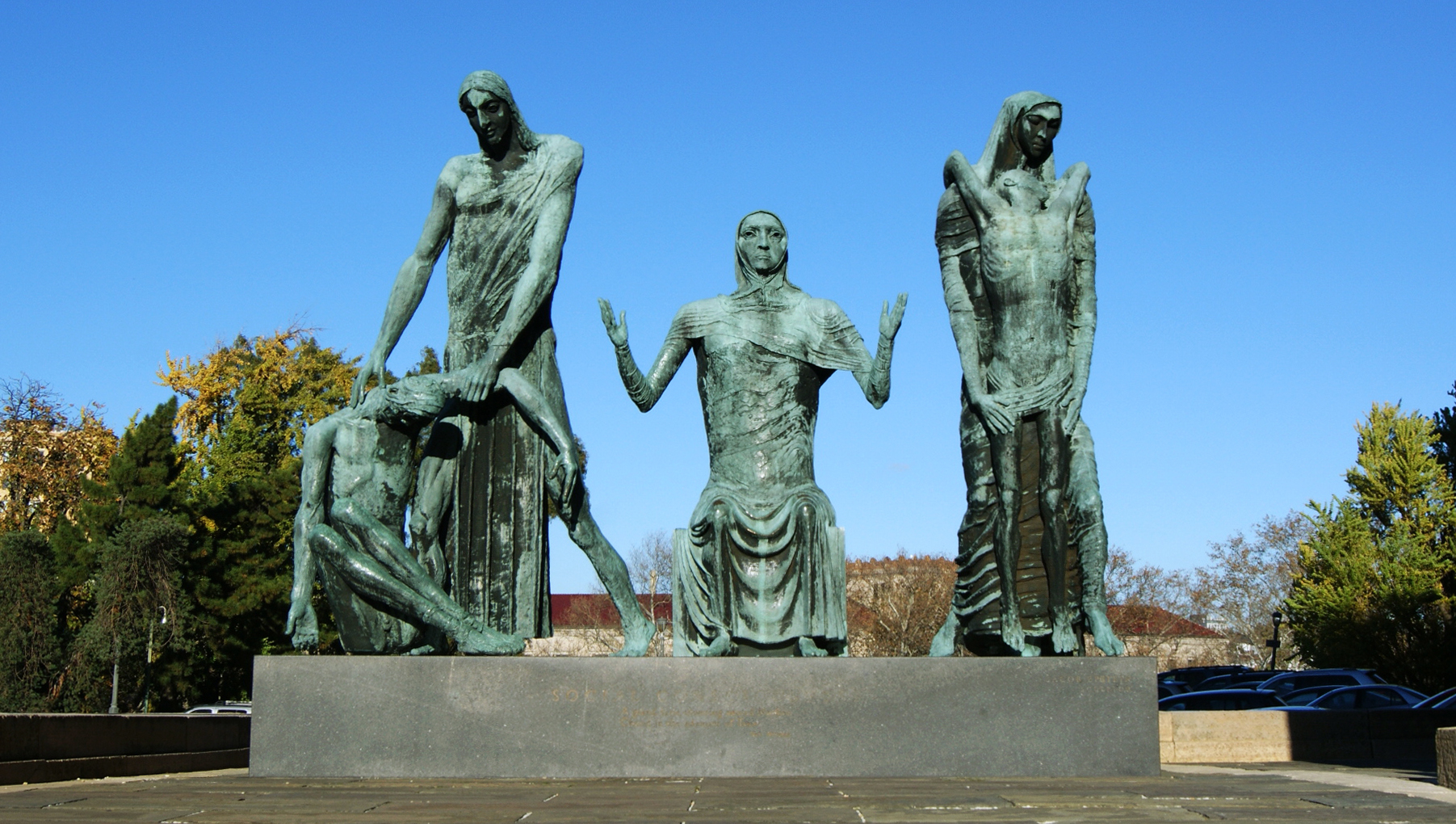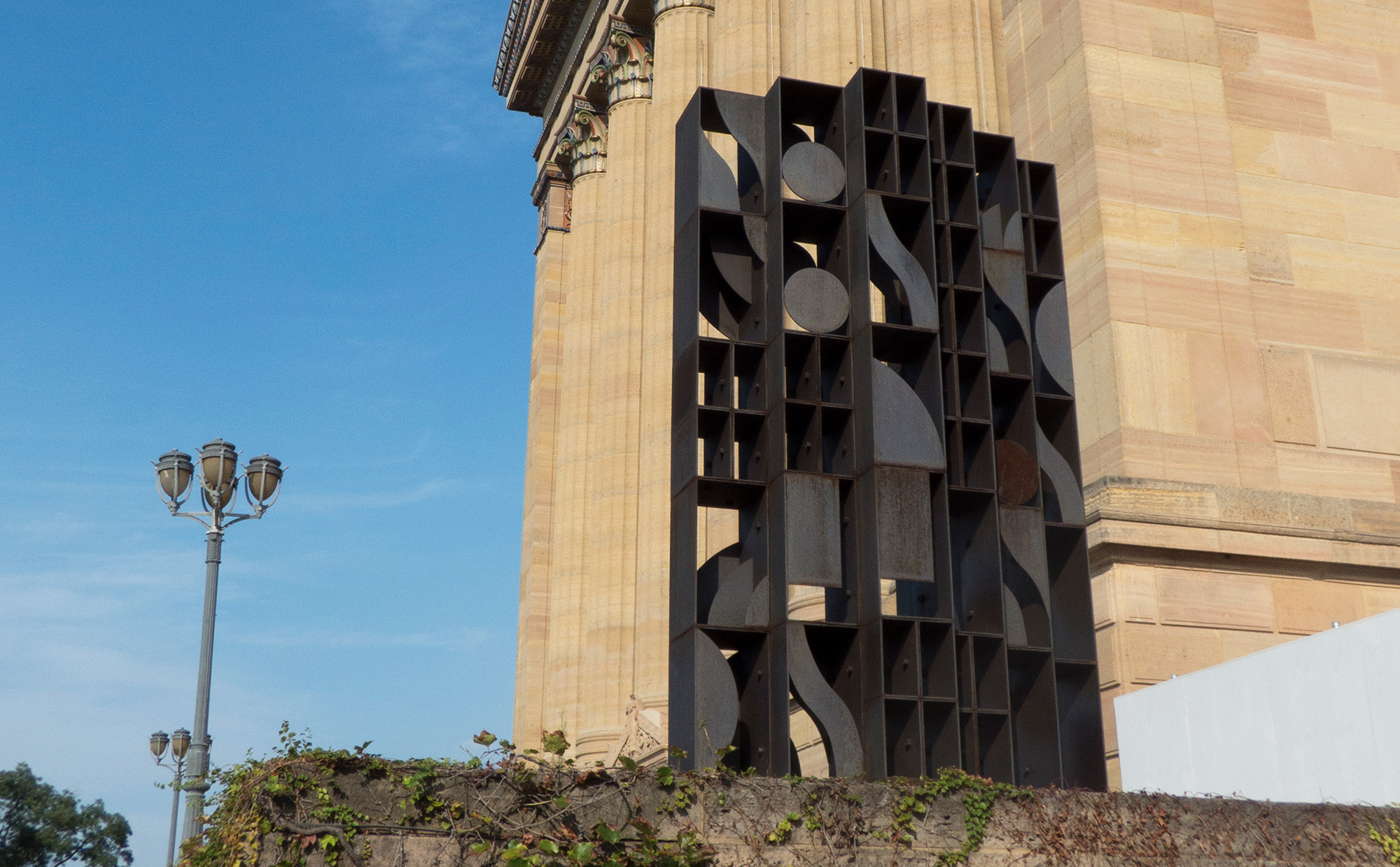PHILADELPHIA – The Association for Public Art (aPA) and the University of Pennsylvania (Penn) announce the relocation of Louise Nevelson’s Atmosphere and Environment XII (1970) and Sir Jacob Epstein’s Social Consciousness (1954) – two large-scale sculptures owned by aPA that have stood at the West Entrance of the Philadelphia Museum of Art for decades. The multi-ton sculptures will be relocated to Penn’s campus on Shoemaker Green and the Memorial Garden Walkway, respectively, and will be on long-term loan to Penn from aPA.
The relocation of these monumental works will begin the week of Monday, July 15th (weather permitting) and require the disassembly of each sculpture. They will be transferred to their new locations by professional conservators, art handlers, and riggers. Reinstallation of the sculptures is intended to begin immediately thereafter. Once relocated, the artworks will receive conservation treatment where necessary, including the removal of any surface grime, and the addition of a protective wax coating for Epstein’s bronze sculpture.

The artworks are being deinstalled from their current location due to extensive renovations at the Philadelphia Museum of Art (PMA), which will include construction at the West Entrance and repaving of the West Terrace. The aPA has taken this opportunity to reconsider the placement and context of these sculptures so they can be seen to their best advantage and remain accessible to the public.
“It was a challenge to simultaneously find new, appropriate locations for two enormous sculptures,” said Penny Balkin Bach, Executive Director & Chief Curator of the Association for Public Art. “We wanted to keep these important artworks in continued public view and avoid placing them in long-term storage, which sometimes is inevitable in situations like this one. We are thrilled to have worked with the University of Pennsylvania to add to the collection of public art on their campus, where the sculptures can be viewed and appreciated by new audiences, and revisited by their existing fans in a different setting.”
The aPA approached Penn with the proposal, a loan of these two important sculptures for a 99-year term. The University began an extensive site survey to identify campus locations that would maximize the impact of these artworks. Penn’s art advisory committee and aPA worked together to finalize the locations.

Epstein’s Social Consciousness will be installed along the Memorial Garden Walkway near the Van Pelt Library. It will be placed in a more contemplative site than its current location, consistent with the artist’s intentions, near works by Alexander Archipenko, Robert Indiana, John J. Boyle, Claes Oldenburg, and Robinson Fredenthal, among others.
“We are delighted to be working with aPA on this historic project and excited to welcome these two important 20th-century sculptures to the heart of campus for the enjoyment of the Penn and Philadelphia communities,” said Lynn Marsden-Atlass, University Curator and Executive Director of the Arthur Ross Gallery. “These pieces will fit perfectly among our sculptures and become integral to experiencing Penn’s campus.”
Social Consciousness was originally commissioned by the Fairmount Park Art Association (now the Association for Public Art) for the Ellen Phillips Samuel Memorial, a series of three terraces along Kelly Drive with multiple sculptures, emblematic of the history of the United States. Once the massive sculpture – intended to express the American ideal of compassion – began to take shape, it became evident that a site within the terraces would not accommodate the work. Social Consciousness was then temporarily installed at the West Entrance of the PMA in 1955, where it was placed on top of a framed wooden box and then eventually on a granite base.
Atmosphere and Environment XII was originally exhibited in France and New York before the sculpture was ultimately purchased by the Association in 1971. Having been unable to find an appropriate “city scape” site, the sculpture was placed at the West Entrance of the PMA where Auguste Rodin’s The Burghers of Calais once stood. After Rodin’s sculpture was relocated to the Rodin Museum, aPA utilized the empty pedestal and placed the Nevelson sculpture there in 1973.
Louise Nevelson’s Atmosphere and Environment XII will be installed at Shoemaker Green (east of 33rd Street between Walnut and Spruce Streets) – a landscaped area near the Palestra arena. The sculpture can be viewed in the round at this new location, which also provides strong silhouettes of the work in both directions.
“Nevelson’s ‘environments’ mimic modern cityscapes and outlines. At this new site, an open space surrounded by buildings, we will see the interplay between the architecture and the sculpture,” says Bach. “You will also be able to read the environment through the artwork, so it will reflect a sense of animated transparency.”
Timothy Rub, George D. Widener Director and Chief Executive Officer at the Philadelphia Museum of Art, explains, “Over the years, our visitors have grown accustomed to being greeted by these imposing sculptures, so the removal of the works is a signal of the many changes taking place at the main building. This fall, the West Entrance will close temporarily to undergo a significant renovation as part of the Core Project of our Facilities Master Plan with architect Frank Gehry. Starting in September, our visitors—in addition to entering the building through the East Entrance—will be able to enter through the North Entrance, which will be reopening to the public for the first time since 1975.”
“The Nevelson and Epstein works will find new homes just across the river where they can continue to be admired by the public,” Rub continued. “It is a wonderful outcome for these sculptures, and we applaud the exceptional collaboration between the aPA and the University of Pennsylvania which has made this happen.”
About Social Consciousness
The Eternal Mother, seated with arms outstretched, casts a solemn, sorrowful look in Social Consciousness by artist Sir Jacob Epstein. Flanking her are two standing female figures: one representing Compassion, reaching down to comfort a stricken youth collapsed at her feet; and another that personifies Succor (or Death), supporting at the hips a young man who bends backward to embrace her shoulders. The entire group by Epstein suggests not only the tenderness and sympathy of humankind but also the affliction that makes these virtues necessary. At the time it was created, Epstein considered Social Consciousness to be his major work. The son of Polish Jewish refugee parents, Epstein was born in the U.S. and emigrated to England as a young man. He was a modern sculpture pioneer, often drawing controversy with his artworks.
About Atmosphere and Environment XII
Atmosphere and Environment XII by artist Louise Nevelson consists of six columns of open rectangular cubes bolted together. Within the cubes are additional geometric shapes, and the entire openwork composition seems to echo the landscape of a modern city. Other sculptures in the Atmosphere and Environment series are located at the Frederick Meijer Gardens and Sculpture Park, Princeton University, Yale University Art Gallery, and Scottsdale, AZ. Another example of Nevelson’s work in Philadelphia is Bicentennial Dawn (1976) at the James A. Byrne Federal Courthouse (interior). Louise Nevelson, an immigrant to the U.S. from present-day Ukraine, was one of the most influential artists in the decades following World War II. She was one of the few women of her time who created large-scale outdoor sculpture.
About the Association for Public Art
The Association for Public Art (aPA, formerly Fairmount Park Art Association) commissions, preserves, interprets, and promotes public art in Philadelphia. The aPA is the nation’s first private nonprofit organization dedicated to creating a “Museum Without Walls” that informs, engages, and inspires diverse audiences. Established in 1872, aPA integrates public art and urban design through exemplary programs and advocacy efforts that connect people with public art. For more information about aPA visit www.associationforpublicart.org
About the University of Pennsylvania
The University of Pennsylvania, founded in 1740, is an Ivy League institution with a distinctive past. Its 12 undergraduate, graduate and professional schools are located in Philadelphia on an attractive urban campus that serves a diverse community of more than 20,000 students from throughout the nation and around the world. Ranked consistently among the top universities in the nation, Penn has a longstanding reputation for excellence in graduate and professional education. For more information visit www.upenn.edu.
University of Pennsylvania Art Collection
The Penn Art Collection contains more than 8,000 artworks, including paintings, sculptures, photography, works on paper, and decorative arts. Many are on view in more than 100 locations on campus, including classrooms, libraries, offices, and along Locust Walk. For more information visit www.artcollection.upenn.edu.
###
